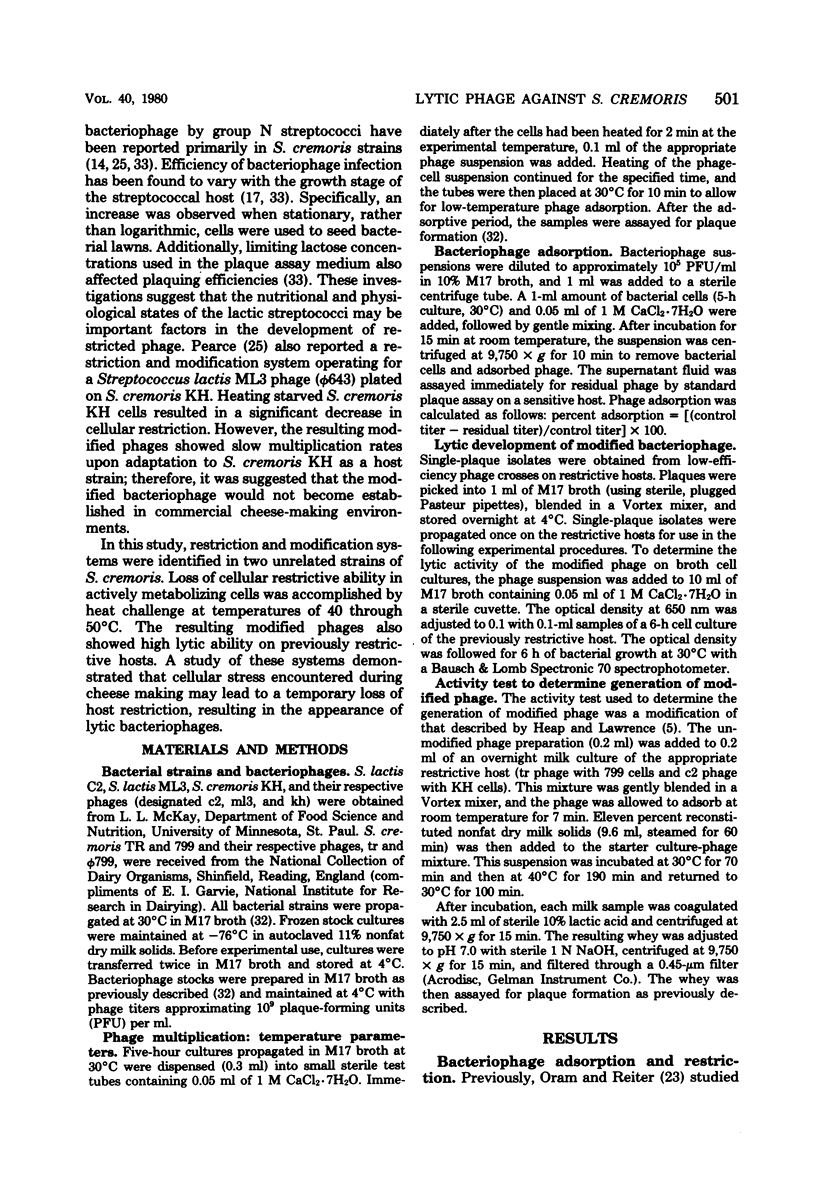Abstract
The appearance of lytic bacteriophage against newly introduced starter strains used during commercial cheese manufacture occurs rapidly, and their origin is not well understood. In this study, members of the group N streptococci were examined for the presence of bacteriophage restriction and modification systems. Two streptococcal phages from Streptococcus cremoris TR and Streptococcus lactis C2 (phage designations tr and c2) showed restricted lytic development on S. cremoris 799 and KH, respectively. Efficiency of plaquing was 1.9 × 10−7 for tr plaqued on 799 and 2.1 × 10−7 for c2 plaqued on KH. After passage through the restrictive hosts, these phages demonstrated high lytic ability for formerly restrictive hosts. Stress of the restrictive host strains at temperatures of 40 to 50°C resulted in a significant increase in the efficiency of plaquing of restricted bacteriophages. Elevated temperatures are encountered during commercial cheese manufacture. The results suggested that the temporary loss of host restriction activity with the resulting modification of nonspecific bacteriophage may contribute directly to the appearance of lytic phage against new starter strains.
Full text
PDF






Selected References
These references are in PubMed. This may not be the complete list of references from this article.
- Arber W., Linn S. DNA modification and restriction. Annu Rev Biochem. 1969;38:467–500. doi: 10.1146/annurev.bi.38.070169.002343. [DOI] [PubMed] [Google Scholar]
- Boyer H. W. DNA restriction and modification mechanisms in bacteria. Annu Rev Microbiol. 1971;25:153–176. doi: 10.1146/annurev.mi.25.100171.001101. [DOI] [PubMed] [Google Scholar]
- COLLINS E. B. Host-controlled variations in bacteriophages active against lactic streptococci. Virology. 1956 Apr;2(2):261–271. doi: 10.1016/0042-6822(56)90021-6. [DOI] [PubMed] [Google Scholar]
- HOLLOWAY B. W. VARIATIONS IN RESTRICTION AND MODIFICATION OF BACTERIOPHAGE FOLLOWING INCREASE OF GROWTH TEMPERATURE OF PSEUDOMONAS AERUGINOSA. Virology. 1965 Apr;25:634–642. doi: 10.1016/0042-6822(65)90091-7. [DOI] [PubMed] [Google Scholar]
- Huggins A. R., Sandine W. E. Incidence and properties of temperate bacteriophages induced from lactic streptococci. Appl Environ Microbiol. 1977 Jan;33(1):184–191. doi: 10.1128/aem.33.1.184-191.1977. [DOI] [PMC free article] [PubMed] [Google Scholar]
- Klaenhammer T. R., McKay L. L. Isolation and examination of transducing bacteriophage particles from Streptococcus lactis C2. J Dairy Sci. 1976 Mar;59(3):396–404. doi: 10.3168/jds.s0022-0302(76)84219-1. [DOI] [PubMed] [Google Scholar]
- Kozak W., Rajchert-Trzpil M., Zajdel J., Dobrzański W. T. Lysogeny in lactic streptococci producing and not producing nisin. Appl Microbiol. 1973 Feb;25(2):305–308. doi: 10.1128/am.25.2.305-308.1973. [DOI] [PMC free article] [PubMed] [Google Scholar]
- Lowrie R. J. Lysogenic strains of group N lactic streptococci. Appl Microbiol. 1974 Jan;27(1):210–217. doi: 10.1128/am.27.1.210-217.1974. [DOI] [PMC free article] [PubMed] [Google Scholar]
- Luria S. E. The recognition of DNA in bacteria. Sci Am. 1970 Jan;222(1):88–passim. doi: 10.1038/scientificamerican017088. [DOI] [PubMed] [Google Scholar]
- McKay L. L., Baldwin K. A. Induction of prophage in Streptococcus lactis C2 by ultraviolet irradiation. Appl Microbiol. 1973 Apr;25(4):682–684. doi: 10.1128/am.25.4.682-684.1973. [DOI] [PMC free article] [PubMed] [Google Scholar]
- Meselson M., Yuan R., Heywood J. Restriction and modification of DNA. Annu Rev Biochem. 1972;41:447–466. doi: 10.1146/annurev.bi.41.070172.002311. [DOI] [PubMed] [Google Scholar]
- Oram J. D., Reiter B. The adsorption of phage to group N streptococci. The specificity of adsorption and the location of phage receptor substances in cell-wall and plasma-membrane fractions. J Gen Virol. 1968 Jul;3(1):103–119. doi: 10.1099/0022-1317-3-1-103. [DOI] [PubMed] [Google Scholar]
- Reanney D. Extrachromosomal elements as possible agents of adaptation and development. Bacteriol Rev. 1976 Sep;40(3):552–590. doi: 10.1128/br.40.3.552-590.1976. [DOI] [PMC free article] [PubMed] [Google Scholar]
- Sjöström J. E., Löfdahl S., Philipson L. Biological characteristics of a type I restriction-modification system in Staphylococcus aureus. J Bacteriol. 1978 Mar;133(3):1144–1149. doi: 10.1128/jb.133.3.1144-1149.1978. [DOI] [PMC free article] [PubMed] [Google Scholar]
- Terzaghi B. E., Sandine W. E. Improved medium for lactic streptococci and their bacteriophages. Appl Microbiol. 1975 Jun;29(6):807–813. doi: 10.1128/am.29.6.807-813.1975. [DOI] [PMC free article] [PubMed] [Google Scholar]
- Terzaghi E. A., Terzaghi B. E. Effect of Lactose Concentration on the Efficiency of Plating of Bacteriophages on Streptococcus cremoris. Appl Environ Microbiol. 1978 Mar;35(3):471–478. doi: 10.1128/aem.35.3.471-478.1978. [DOI] [PMC free article] [PubMed] [Google Scholar]
- UETAKE H., TOYAMA S., HAGIWARA S. ON THE MECHANISM OF HOST-INDUCED MODIFICATION. MULTIPLICITY ACTIVATION AND THERMOLABILE FACTOR RESPONSIBLE FOR PHAGE GROWTH RESTRICTION. Virology. 1964 Feb;22:202–213. doi: 10.1016/0042-6822(64)90005-4. [DOI] [PubMed] [Google Scholar]


